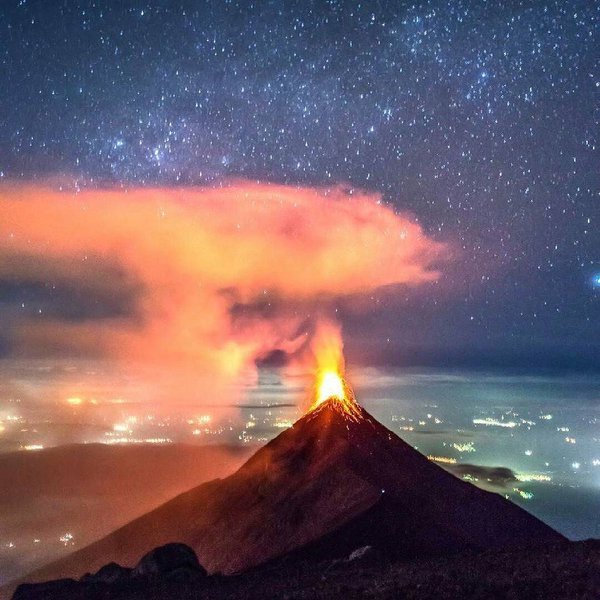
© Maximo Nivel via TwitterFuego volcano eruption, December 15, 2015.
Another phase of strong, increased activity was observed at the Fuego volcano, Guatemala on December 14, 2015, Volcano Discovery reported. Frequent, intense explosions and ash plumes accompanied with loud shock waves marked the 13th paroxysmal episode of the 2015 volcano activity.
Two new lava flows were observed at the Fuego volcano, accompanying intense and frequent explosions on the evening of December 14 (local time).
Between 4 and 6 explosions per hour were reported with ash plumes, followed by loud shock waves, rising up to 1 km (3 280.8 feet) above the volcano summit. New lava flows were 800 m (2 624.7 feet) long and have started to head towards the Santa Teresa on west flank, and Trinidad on south flank drainages.The reported event is the 13th paroxysmal episode of this year, and should the activity of the volcano increase further, dangerous pyroclastic flows could take place over the coming hours or days. Residents have been advised to avoid the river beds and valleys at the feet of the mountain at all times.
INSIVUMEH reported that on November 29, 2015
activity at Fuego increased significantly, characterized by large and strong explosions, ash plumes, and lava flows. Ash plumes rose as high as 2.2 km (7 217.8 feet) above the crater and drifted 40 km (24.9 miles) W and SW. Lava fountains rose 500 m (1 640.4 feet) above the crater, feeding four lava flows that traveled 3-4 km (1.9-2.5 miles) down the Ceniza, Trinidad, Las Lajas, and Santa Teresa drainages.
Ash fell in Panimache I and II (8 km (5 miles) SW), Morelia (9 km (5.6 miles) SW), Santa Sofía (12 km (7.5 miles) SW), El Porvenir (8 km (5 miles) ENE), Yucales (12 km (7.5 miles) SW), Rochelle, Ceylon, and other neighboring communities. Activity declined on November 30; lava fountains rose 100-150 m (328-492.1 feet), and ash plumes rose 1 km (0.62 miles) and drifted 25 km (15.5 miles) WSW. Lava flows were active in five drainages, including the Honda drainage (E flank).
On December 1, weak-to-moderate explosions generated ash plumes that rose 400-800 m (1 312.3-2624.7 feet) and drifted 10-12 km (6.2-7.5 miles) W and SW. Lava fountains continued rising as high as 150 m (492.1 feet). The five lava flows were at most 3 km (1.9 miles) long, and small pyroclastic flows descended the Honda drainage.
Geological summaryVolcán Fuego, one of Central America's most active volcanoes, is one of three large stratovolcanoes overlooking Guatemala's former capital, Antigua. The scarp of an older edifice, Meseta, lies between 3 763 m (12 345.8 feet high Fuego and its twin volcano to the north, Acatenango. Construction of Meseta dates back to about 230 000 years and continued until the late Pleistocene or early Holocene. Collapse of Meseta may have produced the massive Escuintla debris-avalanche deposit, which extends about 50 km (31 miles) onto the Pacific coastal plain.
Growth of the modern Fuego volcano followed, continuing the southward migration of volcanism that began at Acatenango. In contrast to the mostly andesitic Acatenango, eruptions at Fuego have become more mafic with time, and most historical activity has produced basaltic rocks. Frequent vigorous historical eruptions have been recorded since the onset of the Spanish era in 1524, and have produced major ash falls, along with occasional pyroclastic flows and lava flows.
Reader Comments
to our Newsletter